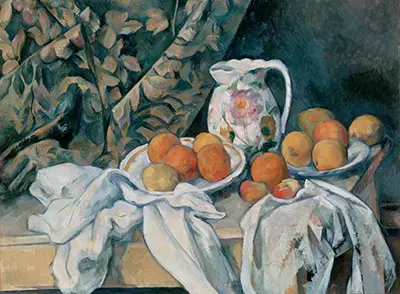It has often been claimed that brevity is the soul of wit. Still Life with a Curtain seems to confirm this maxim; albeit with decidedly artistic undertones. Many experts feel that this piece is one of the most representative and well-known examples of the unique talents espoused by Paul Cezanne.
Although the painting may appear to be somewhat simplistic at first glance, this is hardly the case. There are several nuances which only emerge after careful observation. Furthermore, this work clearly illustrates the talent that Cezanne possessed for still life. One of the reasons why this painting is so immediately striking involves the fact that he was not necessarily concerned with the depiction of textures within the subjects that he painted. This is in stark contrast to many of his 19th-century Dutch contemporaries. On the contrary, his focus was instead on the ability to convey the three-dimensional characteristics of internal elements.
Thus, we can see that many objects within this work (the peaches as well as the background curtain) are defined by a decidedly lack of innate detail. While some professionals at the time such as Henri Rochefort criticised this style as a "love for the ugly", the simple fact of the matter is that Cezanne was creating a unique style of his own. In fact, the majority of modern scholars agree that this work and similar pieces allowed him to create a "bridge" between the predominantly Impressionist 19th century and the new form of Cubism that would come to dominate the early years of the 20th century.
Another hallmark of Cezanne was his ability to create a dynamic sense of tension within his paintings. This is likely due to the fact that a lack of texture immediately draws the eyes to the periphery of objects; emphasising their discrete boundaries. However, we should note here that other famous works such as Madame Cezanne and The Hanged Man's House are both defined by many more repetitive brush strokes. The sense of simplicity displayed by Still Life with a Curtain is therefore slightly unique in the ways in which it affects the viewer.
It is nonetheless important to highlight that while this painting does hint at tension, it also achieves balance in terms of visual form and function. As is characteristic in many of his other words, the use of pastel tones and an avoidance of extremely dark shadows further help this painting to exhibit a light resonance. These are some of the main reasons why Still Life with a Curtain is considered to be one of his most defining pieces.




